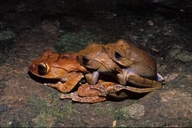|
Description
A large brown treefrog with large dermal flaps on the elbow
and heel; SVL generally 60-80 mm, one male 62 mm, one female 75 mm, one female
from Marojezy 103 mm. Males are smaller than females. Beige to reddish brown
with dark brown bands on the limbs, and sometimes a transverse dark brown line
behind the eyes. Venter creamish. Skin on the back
smooth in females, sometimes granular in males during the breeding season. Iris brown around the pupil with a whitish
ring on the outer iris area. Posterior iris periphery whitish. Nostrils
equidistant between eye and tip of snout. Tympanum distinct, about 1/2 - 2/3
of eye diameter. Tibiotarsal articulation reaches at least tip of snout. Webbing
of the hand 1(1.5), 2i(1.5), 2e(1), 3i(2), 3e(0.5), 4(0.5); webbing of the foot
1(0), 2i(0.5), 2e(0), 3i(1), 3e(0), 4i/e(1), 5(0). Males with nuptial pads and
a slightly distensible, single subgular vocal sac
Similar species:
The only other large species with dermal flaps on the heels and elbows is Boophis
brachychir. Juveniles can be mistaken with other species of the goudotii-group.
Distribution and Habitat
Country distribution from AmphibiaWeb's database: Madagascar
Ambana, Ambatovaky, Ambohitantely, Ambositra, An’Ala, Andasibe, Andohahela, Andringitra (Iantara river, Sahavatoy river), Anjozorobe, Ankazobe, Ankeniheny, Betatao, Chaines Anosyennes, Fierenana, Foulpointe, Itremo, Ivohibe, Manantantely, Mandraka, Midongy, Moramanga, Pic St. Louis, Ranomandry, near Ifanadiana, Vevembe, Ranomafana (Ranomafanakely, Ranomena). Observed from sea level to 1,700 m asl. This species inhabits pristine and disturbed rainforest, and breeds in still or slow-flowing water (Nussbaum and Vallan 2008).
Life History, Abundance, Activity, and Special Behaviors
During
the day, occasionally found in leaf-axils of large plants, in bamboo treeholes
or similar shelters about 1 m above the ground. Males call in the shallow water,
or at the border, of pools and slow-moving brooks, generally on the ground or
up to one meter high, hidden in the vegetation. Amplexus is axillary.
Call (from
Ranomafana): A groaning call, composed of different note types: note type 1
lasts about 170 ms and can be followed by a series of clicks, note type 2. "Click-rate"
is about 12/s and each click lasts about 20-30 ms, with intervals of about 50
ms. The analysed series was composed of 12 clicks and lasted 1 s. Dominant frequency
was about 1 kHz. Similar calls were heard in Andasibe and Tolagnaro.
Eggs and tadpoles:
Black single eggs were found in shallow, slow-moving water, in the shade. One
female (SVL 75 mm) laid a total of 405 eggs. Egg diameter is about
3 mm, including jelly about 7 mm. The brownish tadpoles hatch after one week
and live in slow-moving water, or sometimes in adjacent pools. Total length
in stage 25: 15-45 mm; in stage 34-40: 45-60 mm. The mouth is small and directed
ventrally. At midlength of the tail, the caudal musculature represents about
2/7 of the total tail height. Tooth formula, in general, is 1/4+4//1+1/2, but
varies between 1/3+3//1+1/2 to 1/6+6//1+1/2.
Metamorphosing juveniles measure
13-24 mm from snout to vent. They are coloured light green with dark
brown spots on the back, dark brown bands on the limbs and a transverse dark
brown line behind the eyes. Tympanic fold and canthus bordered with a broad
dark brown band, underneath this band the colour is milky white, with a dark
brown longitudinal band under the eye. After three months, they resemble the
adults.
Trends and Threats
Least Concern: wide distribution and tolerance of habitat modification. It occurs in many protected areas (Nussbaum and Vallan 2008).
Possible reasons for amphibian decline General habitat alteration and loss
Habitat modification from deforestation, or logging related activities
Intensified agriculture or grazing
Urbanization
Habitat fragmentation
Comments
Taken with permission from Glaw and Vences (2007).
References
Glaw, F. and Vences, M. (1994). Amphibians and Reptiles of Madagascar. M. Vences and F. Glaw Verlags GbR., Köln.
Glaw, F., and Vences, M. (2007). Field Guide to the Amphibians and Reptiles of Madagascar. Third Edition. Vences and Glaw Verlag, Köln.
Nussbaum, R. and Vallan, D. (2008). Boophis madagascariensis. In: IUCN 2008. 2008 IUCN Red List of Threatened Species. www.iucnredlist.org. Downloaded on 08 April 2009.
Originally submitted by: Miguel Vences and Frank Glaw (first posted 2000-10-30)
Edited by: Henry Zhu (2009-05-05)Species Account Citation: AmphibiaWeb 2009 Boophis madagascariensis <https://amphibiaweb.org/species/4348> University of California, Berkeley, CA, USA. Accessed Jun 15, 2025.
Feedback or comments about this page.
Citation: AmphibiaWeb. 2025. <https://amphibiaweb.org> University of California, Berkeley, CA, USA. Accessed 15 Jun 2025.
AmphibiaWeb's policy on data use.
|
